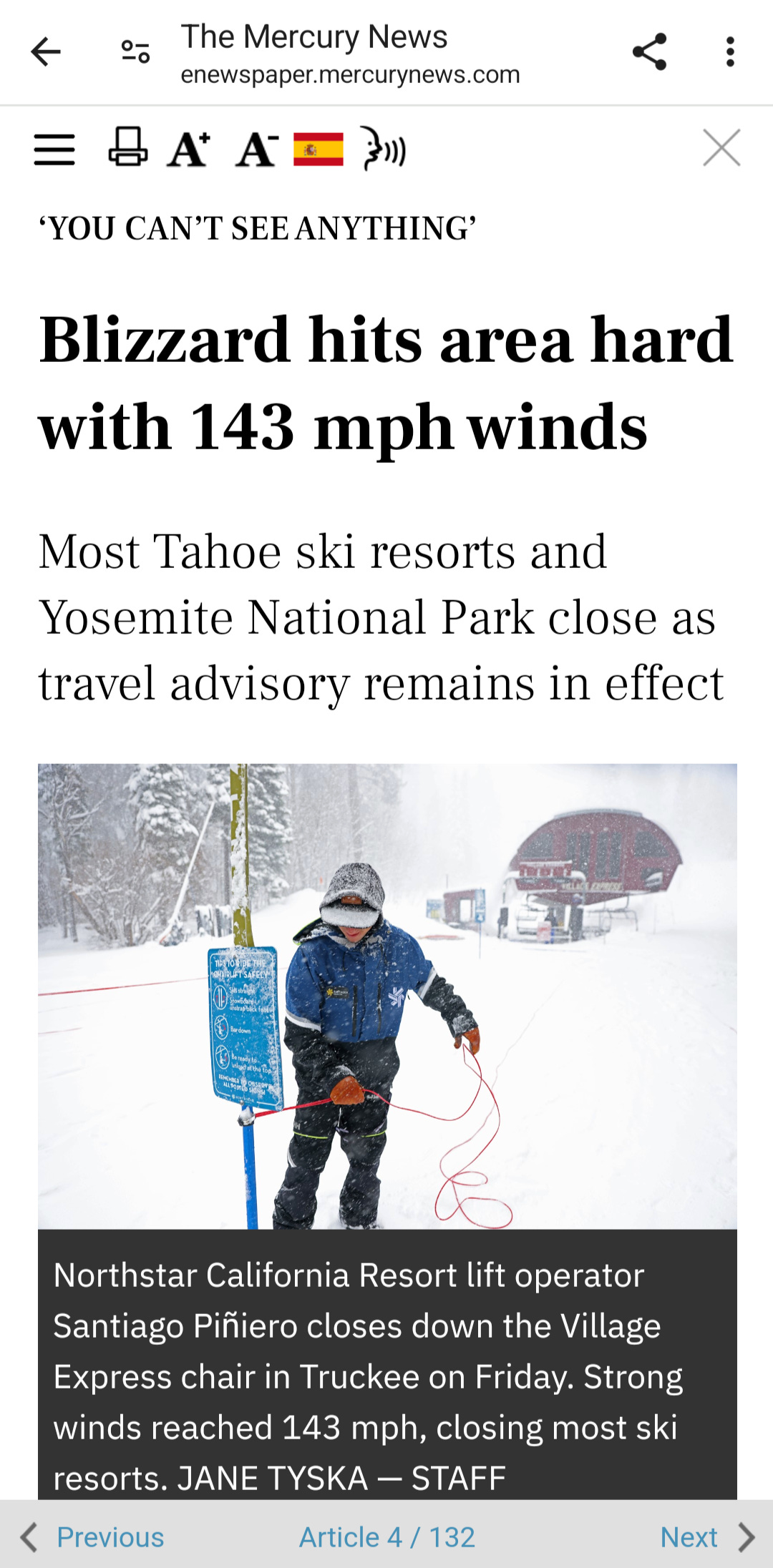Word of the week: Blizzard
It's not the snow, it's the velocity. Plus: Dairy Queen, video games, and some odd name histories.
Weather is today’s topic, but first I want to acknowledge a different blizzard: the surprise flurry of new subscribers and followers during the last couple of days. Hello and welcome! If you’re a recent arrival and have a minute, please tell us in the comments how you found this newsletter and what you’re hoping to read about, learn, discuss, or be amused by.
In the meantime, let’s look at blizzard, a word of mysterious origins that’s been all over the headlines here in California. We are having what the TV guys excitedly call a weather event. And then some.

.

At sea level, where I live, we’re relatively safe: Temperatures are chilly but hardly arctic, the wind is manageable, and the precipitation is liquid. But the snow forecasts for the Sierra Nevada have been dramatic: Two to five inches an hour! Ten feet of new snow by Sunday night! Twelve feet! Thirteen feet!
That is a lot of snow. But snowfall alone isn’t what turns a winter storm into a blizzard. In fact, you can have a blizzard with very little snow.
Here’s ABC News meteorologist Melissa Griffin in a 2016 story:
“A blizzard actually doesn’t have to do with snow totals," Griffin said. "For blizzard conditions, all you need is three hours or longer of sustained winds or frequent gusts up to 35 mph and reduced visibility to less than a quarter of a mile.”
There does have to be some snow, at least on the ground, to create blizzard conditions. But it’s wind, not falling snow, that’s the blizzard-maker.
There are blizzards all over the world, but it took some snow-tormented American Midwesterners to come up with this particular name for them a couple of centuries ago.
The OED says blizzard is “probably an imitative or expressive formation … probably more or less onomatopoeic” (yes, two probablys). In other words, it’s a blizzard because it … sounds blizzardy. The existence of other bl- words like blow, blast, and bluster may have influenced blizzard’s coinage, but despite the French-sounding -ard suffix, “there is nothing to indicate a French origin,” the OED says.
When the word first appeared, in the 1820s, it meant “a violent knock or blow”; by the 1850s that “blow” became the gusty kind: “A furious blast of frost-wind and blinding snow, in which man and beast frequently perish; a ‘snow-squall’.” Here’s a quote from a Kansas settler’s diary in 1859: “A blizzard had come upon us about midnight... Shot 7 horses that were so chilled could not get up.” A century later, even the Brits were resorting to blizzard to describe a certain kind of icy, low-visibility storm.
It’s a wonderful word, characteristic of the 19th-century American spirit that also gave us such vivid coinages as bumptious, discombobulate, sockdolager, and hornswoggle. It’s a lot more evocative, at least to my ear, than its European equivalents, all of which translate to mere “snowstorm” (tormenta de nieve, tempête de neige, Schneesturm).
An excellent word like blizzard could never be satisfied with merely becoming a standard vocabulary item. It also needed to get itself capitalized and turned into a trademark. Many trademarks, it turns out.
The Dairy Queen chain, founded in Joliet, Illinois, in 1940, introduced its “Blizzard treats” in 1985. They’re called “treats” because they don’t contain enough butterfat to qualify as “ice cream,” but that doesn’t mean they aren’t loaded with calories.1

If you’ve played World of Warcraft, as millions of people have (not I, though), you probably have heard of the game’s parent company, Blizzard Entertainment (“Embrace your inner geek”).
The company was founded in California in 1991 by three recent college graduates who gave it a geeky name: Silicon & Synapse. The story of the name’s evolution is such a good cautionary tale that I’m going to quote the Wikipedia passage verbatim:
Around 1993, co-founder [Allen] Adham told the other executives that he did not like the name “Silicon & Synapse” anymore, as people outside the company were confusing the meaning of silicon the chemical element used in microchips with silicone the materials used in breast implants. By the end of 1993, Adham changed the name to “Chaos Studios”, reflecting on [sic] the haphazardness of their development processes.
In early 1994, they were acquired by distributor Davidson & Associates for $6.75 million ($13.3 million today). Shortly after this point, they were contacted by a Florida company, Chaos Technologies, who wanted the company to pay US$100,000 (equivalent to $197,441 in 2022) to keep the name. Not wanting to pay that sum, the executives decided to change the studio’s name to "Ogre Studios" by April 1994. However, Davidson & Associates did not like this name, and forced the company to change it. According to [co-founder Michael] Morhaime, Adham began running through a dictionary from the start, writing down any word that seemed interesting and passing it to the legal department to see if it had any complications. One of the first words they found to be interesting and cleared the legal check was “blizzard”, leading them to change their name to “Blizzard Entertainment” by May 1994.
Note: Not all such dictionary searches prove equally successful.
There are also registered trademarks for Blizzard skis and ski helmets (from Tecnica Group, Italy), Blizzard dental instruments (Eunicare Ltd., U.K.), Blizzard vacuum cleaners (Miele), Blizzard electric fans (Sunbeam), Blizzard bicycles (Industries Rad, Canada), Blizzard beer refrigeration (Cleland Sales Corporation, California), and the rhyming Blizzard Wizard (de-icing salts from Morton Salt, U.S.).
And that’s just a sampling from Page 1 of 85 pages of BLIZZARD trademark records.
One of those trademarks, for Blizzard snowmobiles, has a great backstory. This Blizzard is manufactured by Bombardier Inc., headquartered in Montreal — the company founder was Joseph-Armand Bombardier, a fabulous name in itself — and is a sub-brand of the Ski-Doo line. And Ski-Doo got its name as the result of a spelling error. You can read all about it here.
The trademark filing defines Blizzard treats as “heavy-bodied milkshakes” and “milk shakes and semi-frozen ice milk and ice cream” (emphasis added), which goes to show that federal agencies — in this case, the U.S. Patent and Trademark Organization and the Food and Drug Administration — don’t always agree.






Since you asked, I found you through Jane Friedman's Electric Speed newsletter. She recommended your newsletter. I'm glad she did! I love the history of words.
...Please tell us in the comments how you found this newsletter and what you’re hoping to read about, learn, discuss, or be amused by...
Not really new here but I would like to know the meaning of life.